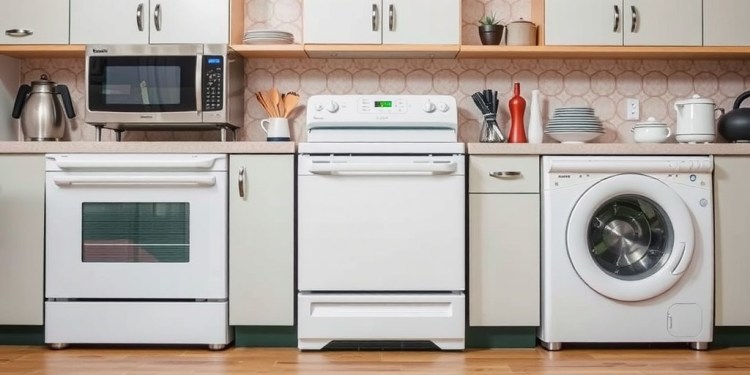
In a world where consumers frequently express concerns about the longevity of their home appliances, recent research offers a nuanced perspective on this issue. The assumption that modern appliances, particularly large ones like washing machines and ovens, are becoming less durable is prevalent among various households. However, Kamila Krych’s research from the Norwegian University of Science and Technology (NTNU) challenges this notion, revealing an interesting distinction in appliance longevity trends. Through her PhD research within the Industrial Ecology Programme at NTNU, Krych delves into the actual lifespan of several household appliances over the past decades, presenting findings that contradict popular belief.
Krych’s research examines the lifetime trends of large appliances adopted by Norwegian households since the 1950s. While the public’s perception is influenced by anecdotal evidence and individual experiences, her investigation indicates that most large appliances have maintained consistent lifespans over the years, with one notable exception. These exceptions are washing machines and ovens, two appliances that have experienced marked decreases in their operational lifetimes. This decline suggests that factors influencing consumer behavior and household dynamics play a vital role in the longevity of these products.
In examining the specifics, Krych’s findings reveal that the lifespan of washing machines has diminished by a staggering 45 percent, reducing from an average of 19.2 years to just 10.6 years. Similarly, ovens have seen their lifetimes decrease by 39 percent, from 23.6 years to approximately 14.3 years. This evidence strays from the hypothesis that all appliances are losing durability; instead, it points toward unique patterns associated with these two types of appliances. Such significant reductions inadvertently raise questions about the underlying factors that contribute to this decline, prompting Krych to explore further into the usage patterns and societal habits surrounding these appliances.
The decline in washing machine longevity, according to Krych’s analysis, can largely be attributed to changing consumer behaviors regarding laundry. The frequency of laundry cycles per week has surged dramatically over the decades. Citing a study from 2003, Krych notes that in 1960, a typical Norwegian family would perform laundry twice weekly. By the year 2000, this frequency had risen sharply, leading to an average of eight laundry cycles per week for the same family size. Such a monumental shift in usage undoubtedly impacts the wear and tear on appliances, resulting in shorter lifespans for those subjected to high usage rates.
Another factor contributing to the waning lifespan of ovens appears to be linked to evolving kitchen dynamics and consumer behavior regarding appliance integration within modern kitchens. Krych identifies a compelling trend whereby approximately 40 percent of all ovens in Norway are discarded while still functional. This phenomenon is notably unique to ovens, reflecting a growing tendency for consumers to prioritize aesthetics and modernity over functional longevity. As kitchens undergo renovations, it’s often deemed more convenient and financially manageable for consumers to replace all appliances at once, rather than retaining an oven that still serves its purpose.
Furthermore, Krych’s insights extend beyond the individual appliance data, revealing patterns that suggest a convergence in the lifetimes of different appliances within the same space, specifically kitchens. The lifetimes of refrigerators, dishwashers, and washing machines, for instance, have started to align more closely as consumers shift toward newer kitchen designs that favor integrated, aesthetically pleasing appliances. This trend hints at a consumer mindset that values the visual cohesion of the kitchen environment over the practicality of retaining functioning appliances for longer periods.
The integration of living spaces with kitchens signals a broader social change, where the kitchen’s role morphs into a multifaceted area, often serving as a social hub for family gatherings and interactions. With this shift comes increased scrutiny toward the design and appearance of kitchens, driving consumers to favor new styles over retaining older, functional appliances. Thus, Krych emphasizes the necessity of considering how consumer lifestyles and evolving societal norms have conspired to shape appliance longevity.
While current environmental policies aim to promote the durability of products and encourage repair over replacement, Krych argues that such initiatives would benefit from a more holistic approach. Taking into account social changes alongside product durability is essential for crafting effective policies that respond appropriately to consumer behaviors. Appliances are not mere commodities but are deeply embedded in the fabric of daily living, impacting the ways individuals engage with their household responsibilities.
Krych’s findings culminate in a poignant reminder that consumer behavior and societal trends are intricately linked. The evidence suggests that a simplistic view of product durability falls short of capturing the complexities surrounding appliance lifespans. By recognizing the role of lifestyle changes, policymakers can better tailor their strategies to address the underlying factors contributing to the decline in appliance longevity, ultimately fostering a more sustainable consumer culture.
In conclusion, Kamila Krych’s research presents significant implications for both consumers and policymakers. As the dialogue around sustainability and the environmental impact of our consumption patterns continues, understanding the forces shaping appliance lifetimes becomes increasingly crucial. By bridging the gap between product design and consumer behavior, stakeholders can cultivate a future where durability is not just a desirable quality but a standard expectation.
Subject of Research: Long-term lifetime trends of large appliances since the introduction in Norwegian households
Article Title: Long-term lifetime trends of large appliances since the introduction in Norwegian households
News Publication Date: 3-Jan-2025
Web References: DOI link
References: Krych, K. & Pettersen, J. B. (2025). Long-term lifetime trends of large appliances since the introduction in Norwegian households. Journal of Industrial Ecology.
Image Credits: Not available
Keywords
Consumer behavior, appliance longevity, washing machines, ovens, sustainability, kitchen design, Norway, environmental policy.
Tags: appliance lifespan trendschanges in appliance quality over timeconsumer perceptions of appliance durabilitydurability of major appliancesfactors affecting appliance durabilityhousehold appliance lifespan researchindustrial ecology and appliancesNorwegian appliance longevity studyoven longevity issuesresearch on home appliance longevitytrends in home appliance usagewashing machine lifespan decline






